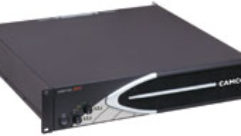
Audio Technology Transforms Museums
Jun 1, 2009 12:00 PM,
By Dan Daley
Integrating sound into modern displays calls for innovative solutions.

In many museums across the country, sound plays an important role. Exhibits increasingly incorporate sound and video, and making sure that sound doesn’t spill out from one exhibit to another is an important concern for systems integrators when designing an installation.
The word “museum” still tends to conjure up images of dusty books and statues connected by the occasional spider web. The technology and design dedicated to museums, however, has transformed this growing sector, particularly when it comes to audio, which is being used to create immersive environments for especially intense museum scenarios. One prime example: the National Museum of the Marine Corps in Triangle, Va., where attendees step into an actual CH-46 Chinook helicopter transport. The exhibit simulates a flight into a hot landing zone during the 1967 Battle of Hill 881 in Vietnam, and it includes sounds of incoming flak and small-arms fire and intercom chatter between pilots and crew chiefs.
Music is also driving this new focus on audio to complete the museum experience. There are close to two dozen museum facilities focused on national or regional music, including the Motown Historical Museum in Detroit; the Alabama Music Hall of Fame in Tuscumbia, Ala.; Delta Music Museum in Ferriday, La.; Stax Museum of American Soul Music in Memphis, Tenn.; the Country Music Hall of Fame and Museum in Nashville, Tenn.; and of course, the Rock and Roll Hall of Fame and Museum in Cleveland.
However, audio is also the most challenging of the museum integration crafts, as a few case studies reveal. Fortunately, industry professionals these days are crafting innovative solutions to these challenges.
Focused Sound in Philly
At the National Constitutional Center in Philadelphia, Andrew Kidd, a Burlington, N.J.-based technology consultant with Electrosonic—one of a handful of companies that specialize in museum-technology integration—faced a design for the facility that would make manifest the mechanics of the U.S. Constitution inside what is essentially a glass doughnut. Glass walls run in a circle around the perimeter of the building, and a smaller circle of glass encloses a theater in the hole of the doughnut. The glass walls—which have some of the highest reflective properties of any surface—weren’t fixed parallel to each other, but the potential for reflections that could distort sound was significant. At the same time, the interior architectural design called for wide-open spaces with few walls that could act as sound barriers or insulators. The few walls that do exist are often integral parts of the exhibits, which further limits their usefulness as sound controllers.
Kidd says his team looked for low-hanging fruit first—stuffing sound-deadening material around the backs and sides of video soffits. They were also able to work some carpets in to help minimize reflections off the hard terrazzo floors. Larger issues, however, needed a combination of technology and technique to resolve them.
“Seventy percent of the vertical surfaces in the museum are glass, and the exhibits are placed throughout the open floor plan. The challenge was to give each exhibit space its own audio environment that had sufficient volume to allow it to be heard and understood, but not so loud as to distract a visitor at an adjacent exhibit,” Kidd says.
The technology solution involved several of Dakota Audio‘s focused-beam audio systems, the 36″x36″ FA 501 array or the smaller 24″x24″ MA-4. Both are field-adjustable for mounting height and pattern width. There are two push buttons and two rows of LEDs on the top side of the array. One button adjusts the mounting height above the floor in 1ft. increments from 8ft. to 14ft. The other button controls the pattern width in seven steps from a tight spot to a circle 10ft. in diameter. But as focused and directional as the audio beam is, it still needs to be precisely positioned to make maximum use of the floor space.
At a display that involves leaning forward toward a desk, a pair of FA 501 steerable arrays were placed in the floor, aimed up, and angled toward the space where a person would stand—about a 4ft. to 6ft. throw.
“It’s not a stereo audio program, but you need to support the sound on either side of the listener to keep the balance and to make the experience immersive,” Kidd says. “With the right angle on the array, you can walk away a couple of feet and not hear a thing.”
Audio Technology Transforms Museums
Jun 1, 2009 12:00 PM,
By Dan Daley
Integrating sound into modern displays calls for innovative solutions.

Focused-beam audio systems help localize audio to a particular exhibit. Dakota Audio
FA 501 arrays and the smaller MA 4 arrays are field-adjustable for mounting height and pattern width. Even with the adjustability, the audio beam needs to precisely positioned.
That same technique is used near a large inverted cone of images, where the arrays were aimed for that same 4ft. to 6ft. target—about the height range of the heads of adults and children—and then the height of the space itself dissipates the audio before it can reach a reflective surface.
In other instances, conventional loudspeakers could be used, such as the Tannoy i5 loudspeakers, which were also floor-mounted around larger exhibits. The ex¬hibits used EAW DX810 DSP units for delays to match the audio to the picture displayed on large screens. But with all the floor-mounted loudspeakers, the positioning was critical because the forms and the cable troughs needed to be in place and precisely positioned before the concrete was poured.
“The floor was the best place to put speakers of any kind to get the sound as close as possible to the visitor,” Kidd says. “But it was a huge project-management proposition. We had to determine from the plans where the speakers needed to go, and then we only had a few days to line them up exactly with tape measures and lasers. If it went in wrong, there would have been no way to fix it.”
Timely exhibit
At the Museum of Chinese in America, which is scheduled to reopen June 26 in New York, VideoSonic Systems president and CEO Glenn Polly used several types of focused-beam loudspeaker solutions for various facets of the installation. In a timely exhibit about how interrogation techniques were used on Chinese immigrants at the turn of the 20th century, a chair is set up with a display in front of it, allowing the user to determine the intensity of a faux interrogation, accompanied by concomitantly more intense sound effects. Since the levels of the audio will vary according to each user’s tolerance, and since the exhibit is nearly adjacent to another, the sound had to be highly localized. VideoSonic used Holosonics‘ Audio Spotlight focused-beam loudspeaker directly overhead.
For the five stations where images of immigrants are accompanied by their audio narratives, the company used Dakota Audio FA 501 units placed directly above each station with a motion sensor that triggers the audio program to minimize the footprint of each station. The choice, Polly says, was dictated by the content.
“The Holosonic speaker is significantly more intensely focused, but the nature of how it does it does not lend itself to full-frequency audio, and the portrait narratives have both spoken word and music, for which the Dakota speakers are a better fit,” Polly says. “Not quite as tight a focus, but with a fuller frequency range.”
Also adding to the ability to fine-tune the loudspeaker focus is the fact that the audio and the video signals run on Cat-5 cabling, they are controlled and routed by a Crestron QuickMedia system, and they are digital until just after the DSP stage of that system. The system then applies various types of equalization (graphic and parametric) for each endpoint in the museum.
“Frequency is another way to control the directionality of the sound,” Polly says. “We can also compensate to some degree for any acoustical issues at that point, and we can add resolution with the tone controls that can let us, for instance, add midrange and high end to a recording with scratches and other artifacts.”
In this case, the larger message is that while it’s about focusing the sound, it’s also about making sure the content is easily heard. Bad sound can distract listeners, and they lose focus that way.
Audio Technology Transforms Museums
Jun 1, 2009 12:00 PM,
By Dan Daley
Integrating sound into modern displays calls for innovative solutions.
Choosing loudspeakers is also a function of how large and tight a perimeter you need to establish. Polly says the highly concentrated beams from the Audio Spotlight and American Technology‘s HSS loudspeaker are best if only one viewer at a time is interacting with an exhibit. If the space can accommodate more, he’ll use the Dakota’s cardioid (heart-shaped) reproduction pattern or the pancake pattern of the Brown Innovations SonicBeam 24, which covers a larger area, but drops off dramatically within a very short throw from the point source.
“We’ve even made our own focused-beam speaker solutions,” Polly says. “The point is, there are a number of solutions available that you can use to fit each situation as perfectly as possible.”
Related Links

The Buzz: Installation Spotlight: The Touch and Feel of Music
Modern society is never too far from its music, from cell phone ringtones to music-infused commercials to satellite radios to, of course, our MP3 music players. It’s only natural, then, that there should be a high-tech museum devoted to music…

In this issue’s cover story on the design and installation of a shining new AV infrastructure inside the California Academy of Sciences facility,…

Installation Profile: Shedding Light on Franklin
Michael Mountjoy is the computer specialist for the Franklin Institute Science Museum in Philadelphia, and he’s also an amateur climber. His skills with…
Great Wide Open
Not all museums are indoors. The Springs Preserve in Las Vegas is a 180-acre park that commemorates the city’s dynamic history and looks forward to a sustainable future. The site is named for provided water to ancient Native Americans and later to settlers traveling west. BBI Engineering of San Francisco was asked to create a soundscape inside a large faux canyon.
“The real challenge here was the sheer scale of it,” says Phil Bailey, a principal of BBI. “There was an enormous amount of cabling to run to cover a wide area, about a half an acre in total. We ran very heavy Belden 12-gauge wire in conduit underground from the control room in the museum building to various distribution points on the canyon grounds, then ran Belden 16-gauge wire from there to over 60 speakers scattered around the property.”
Bogen Near A6T loudspeakers were chosen for their weather-resistance in what is a hot, dry, and occasionally turbulent meteorological environment. The audio program—eight discrete tracks playing continuously from a BBI 4MP3-MSC MP3 player through a pair of QSC CX602V 70V amplifiers—was created from actual recordings of the type of wildlife found in the region, which includes buzzards and coyotes. The loud¬speakers are distributed in such a way that a visitor will hear between four and six of the eight discrete audio programs at a time. Rather than camouflaging the loud¬speakers to look like rocks, BBI chose to hide them within the landscape, behind real rocks and with carefully cut openings to port the sound.
The audio program is by definition hypernatural; it would be odd for all of the sound sources to occur simultaneously in the wild because some animals are nocturnal and others are diurnal. But to achieve a comprehensive aural effect, the programs run together to keep it interesting for the visitor, but they are also positioned according to the type of sound they’ll be used for.
“If the program calls for bird sounds, the speakers will be located off the ground on a boulder or an outcropping,” Bailey says. “If the sounds are ground-dwelling critters, the speakers are hidden on the ground among the rocks.”
Audio Technology Transforms Museums
Jun 1, 2009 12:00 PM,
By Dan Daley
Integrating sound into modern displays calls for innovative solutions.
Born To Be Styled
Sound is critical to the Harley-Davidson Museum in downtown Milwaukee. In fact, the motorcycle maker once famously tried—and failed—to secure a copyright on the exhaust sound of its motorcycles. So Communications Electronic Design (CED) of Louisville, Ky., was not surprised when the museum’s content design called for 72 channels of audio throughout the 350,000-square-foot facility.
In response, the company created an interface for a Richmond Sound Design AudioBox AB64 audio server that serves as an advanced matrix router, sending any input to any amplifier or loudspeaker destination throughout the facility. It also allows individual control over input and output levels, crossfades, and equalization via an AMX MVP-8400 wireless touchscreen panel. That panel will allow museum management to adjust individual levels and sonics for the first few months after opening as crowds in the museum—a large, open steel-and-concrete space with no shortage of sound reflections, which Harley specifically wanted to create larger-than-life engine sounds—ebb and flow.
“Once they establish the relative levels for various crowd sizes, we can program the presets into the server,” says Mandie Clark, CED design engineer on the project.
Since the client didn’t require a high degree of isolation, sound reproduction was dictated as much by aesthetics as sonics. JBL Control 126W speakers were used throughout the installation. Paintable cover plates were used when needed to blend into the décor, such as the bright orange color used in the Engine Room, where visitors can listen to various tunings of that famous throaty roar. An M-Audio BX10 subwoofer was added to that part of the exhibit to enhance low-frequency reproduction.
The Harley-Davidson Museum is a good example of how lack of isolation can be used to make a visit to the museum a shared experience that heightens the effect for visitors. All of these museums reflect the fact that, regardless of how you immerse the patron—as a group or as individuals—audio has become a key component of any exhibit.










